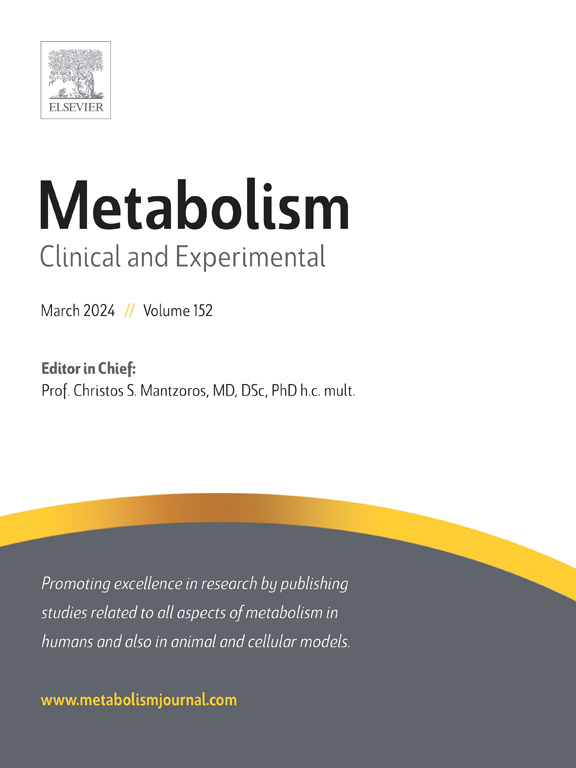红肉消费与2型糖尿病风险之间关系的饮食背景
IF 10.8
1区 医学
Q1 ENDOCRINOLOGY & METABOLISM
引用次数: 0
摘要
研究表明,与红肉相关的饮食因素可能导致其对健康的不利影响,而在健康饮食中食用红肉不一定会增加疾病风险。方法在来自三个前瞻性队列的204,740名参与者中,我们通过替代健康饮食指数(AHEI)-2010(不包括红肉和加工肉成分),使用多变量调整的Cox比例风险模型,研究了不同饮食质量水平下红肉消费与2型糖尿病(T2D)风险之间的关系。通过重复的食物频率问卷来评估饮食摄入量。结果在28年的中位随访期间,记录了18,868例病例。AHEI-2010的平均值分别为47.3份(SD 8.5)、6.5份(SD 3.5)、1.8份(SD 1.5)和4.8份(SD 2.5),分别为总红肉、加工红肉和未加工红肉。在AHEI-2010各阶层中,更多的红肉消费始终与更高的T2D风险相关。在饮食质量最高的五分位数中,对红肉消费量最高和最低的五分位数进行比较,多变量调整后的hr分别为:总红肉1.95(1.72,2.21),加工红肉1.88(1.67,2.13),未加工红肉1.67(1.47,1.90)。用主要的食物种类代替红肉与较低的糖尿病风险有关,尤其是那些饮食质量高的人。在饮食质量较高的参与者中,减少红肉摄入量的好处更大。结论:即使在饮食质量相对较高的参与者中,与高红肉消费相关的风险仍然存在,这强调了限制红肉消费对预防糖尿病的重要性。本文章由计算机程序翻译,如有差异,请以英文原文为准。
Dietary context in the association between red meat consumption and risk of type 2 diabetes
Background
It has been suggested that dietary factors correlated with red meat may contribute to its adverse health effects, while consuming red meat within a healthy diet may not necessarily increase disease risk.
Methods
Among 204,740 participants from three prospective cohorts, we examined the association between red meat consumption and risk of type 2 diabetes (T2D) across different levels of diet quality, measured by Alternative Healthy Eating Index (AHEI)-2010 (excluding red and processed meat component), using multivariable-adjusted Cox proportional hazards models. Dietary intake was assessed using repeated food frequency questionnaires.
Results
During a median follow-up of 28 years, 18,868 cases were documented. Mean values were 47.3 (SD 8.5) for AHEI-2010 and 6.5 (SD 3.5), 1.8 (SD 1.5), and 4.8 (SD 2.5) servings/week for total, processed, and unprocessed red meat, respectively. Greater red meat consumption was consistently associated with a higher T2D risk across AHEI-2010 strata. Comparing the highest with the lowest quintile of red meat consumption in the highest diet quality quintile, the multivariable-adjusted HRs were 1.95 (1.72, 2.21) for total, 1.88 (1.67, 2.13) for processed, and 1.67 (1.47, 1.90) for unprocessed red meat. Substituting red meat with major food groups was associated with a lower T2D risk, particularly among those with high diet quality. The benefit of lowering red meat consumption was greater in participants with higher diet quality.
Conclusions
The risk associated with high red meat consumption persisted even among participants with a relatively high diet quality, underscoring the importance of limiting red meat consumption to prevent T2D.
求助全文
通过发布文献求助,成功后即可免费获取论文全文。
去求助
来源期刊

Metabolism: clinical and experimental
医学-内分泌学与代谢
CiteScore
18.90
自引率
3.10%
发文量
310
审稿时长
16 days
期刊介绍:
Metabolism upholds research excellence by disseminating high-quality original research, reviews, editorials, and commentaries covering all facets of human metabolism.
Consideration for publication in Metabolism extends to studies in humans, animal, and cellular models, with a particular emphasis on work demonstrating strong translational potential.
The journal addresses a range of topics, including:
- Energy Expenditure and Obesity
- Metabolic Syndrome, Prediabetes, and Diabetes
- Nutrition, Exercise, and the Environment
- Genetics and Genomics, Proteomics, and Metabolomics
- Carbohydrate, Lipid, and Protein Metabolism
- Endocrinology and Hypertension
- Mineral and Bone Metabolism
- Cardiovascular Diseases and Malignancies
- Inflammation in metabolism and immunometabolism
 求助内容:
求助内容: 应助结果提醒方式:
应助结果提醒方式:


